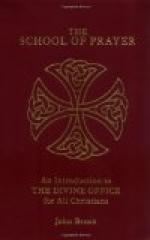Contents. Originally the matter for Prime was drawn from Lauds and was a repetition of part of Lauds. Prime consists of two parts. The first part consists of hymn, psalms, little chapter and collect. The prayers and confiteor inserted before the collect and said on certain days are adjuncts. The second part contains the Martyrology (when Prime is said in choir) and other prayers peculiar to the Hour. “The reason for this divergence may be traced to the fact that Prime is of monastic institution and the second portion, which is said in the chapter house, has reference to monastic customs. The Martyrology and Necrology having been read, prayers were said for the dead recommended to the Community, as benefactors, friends, patrons, protectors, etc. Then followed a special prayer in preparation for manual labour of the day, and a chapter of the rule was read, on which the Abbot briefly commented or else gave some admonition to the Community. This monastic character will be easily recognised by a glance at the formulas used. The prayer, ‘Sancta Maria et omnes sancti’ forms a natural conclusion, to the reading of the Martyrology, The ‘Deus in adjutorium,’ the ‘Pater Noster’ with accompanying versicles, and the collect, are the prayers before manual labour: ‘Respice,’ etc., Look, O Lord, upon Thy servants and upon Thy works... and direct Thou the work of our hands. ’Dirige et sanctificare,’ etc., ’Vouchsafe to direct and sanctify our senses, words and actions,’ etc. Whilst the ‘Dominus nos benedicat’ and the ’Fidelium animae’ are the conclusion of the prayers for the dead” (Dom Cabrol, Introduction to the Day Hours of the Church).
Structure:-i. Pater, Ave, Credo, silently. 2. Deus in adjutorium. ... Domine ad adjuvandum .. with sign of the cross, Gloria Patri. ... Sicut erat. ... 3. Hymn, fam lucis. 4. Antiphon, first words only. 5. Psalms for the Sunday or feria as rubrics direct, with the Athanasian Creed if it be ordered, then the antiphon in full. 6. Regi saeculorum ... or, Pacem et veritatem. ... Deo Gratias, Christie, Fili Dei vivi.... 7. Preces, if they are ordered in the Office of the Day, Preces Dominicales or Preces feriales as rubrics direct. These include versicles, responses, confiteor, misereatur... indulgentiam... versicles responses. 8. Dominus vobiscum. Et cum spiritu tuo. Oremus, Domine Deus..... Amen. Dominus vobiscum, Et cum spiritu tuo. 9. Benedicamus Domino, Deo Gratias.




